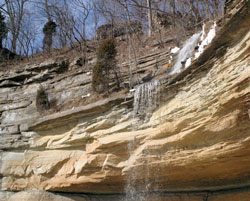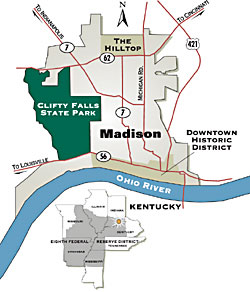Community Profile: Well-Preserved Madison, Ind., Looks to Attract More than Just Tourists
When the Ohio River overflowed its banks at Madison, Ind., in 1997 and water rose to the top of some rooftops, one century-old house was knocked off its foundation. After evaluating the damage, the federal government agreed to pay for the home to be torn down. But when Madison's Historic Preservation Board heard about this, it swooped in to save the house.
Welcome to Madison, where Mother Nature is no match for the local preservation movement. As one Madisonian says, only partly in jest, "When we see an empty building around here, we don't knock it down; we turn it into a museum." Madison's eight museums are located in 19th century buildings downtown, all 133 blocks of which are listed on the National Register of Historic Places.
"The preservation consciousness here is part of the secret of why Madison is such a draw," says Gary McConnell, who operates the Lanham House Bed and Breakfast and Café Express coffee shop on Main Street. "I hear all the time from my guests, 'We can't believe what a Mayberry-esque kind of town Madison is.'"
Situated within 90 minutes of Louisville, Cincinnati and Indianapolis, Madison is a tourist destination for many. With bed and breakfasts, cafes, antique shops, churches and a fountain lining Main Street and with a scenic riverfront featuring a park, brick walkways, visiting riverboats and regularly scheduled festivals, Madison holds much appeal for the workaholic in need of a recharge.
But many residents here share the sentiment of David Terrell, executive director of the Madison-Jefferson County Industrial Development Corp., who says, "Madison cannot thrive solely on tourism." To sustain itself economically, Terrell says Madison needs to build on its industrial base while also bringing higher-paying technological jobs to town.

Attracting high-paying technology jobs to Madison is a primary goal of David Terrell of the industrial development corporation.
"Two Cities in One"
Madison's quaintness is partly due to geographical quirkiness. One side of downtown hugs the river, while the rest is surrounded by rolling hills. But a three-mile drive up the hills reveals a different world, an area locals call the Hilltop.
"Madison, to me, is unique," says Matt Forrester, president of River Valley Financial Bank, which sits on the Hilltop. "It's truly two cities in one. You have the downtown area with its more old-world retail below the hill, and the more commercial and industrial parts of town up on the Hilltop."
Adds McConnell, "It allows us to keep the historic flair going down here, untainted by new things."
The Hilltop includes a series of strip malls, fast-food restaurants and a Wal-Mart Supercenter. It also is home to a diverse group of manufacturers, including Madison's two largest industrial employers—Arvin Sango Inc. and Grote Industries.
Arvin Sango produces exhaust system assemblies, vehicle body stampings and other automotive parts. The company, a joint venture created in 1988, has a majority of Toyota's exhaust business, including supplying products to the automaker's two nearby assembly plants, in Georgetown, Ky., and Princeton, Ind.
Grote Industries is a leading producer of vehicle safety systems, mainly sophisticated lighting products for commercial vehicles, such as delivery trucks and tractor-trailers. The company moved its headquarters to Madison in 1960. Family-owned since it started operations at the turn of the 20th century, Grote's sales totaled $150 million last year, according to Bill Grote, company president. He says Madison offers an inviting business climate.
"Madison is a vibrant, thriving community with a really active chamber of commerce," Grote says. "The assets of the town, with the historic area and the river, make for a good living environment for raising children."

Hanging Rock Hill, located between downtown and the Hilltop, is part of Madison's scenic landscape.
Seeking "Intellectual Capital"
Terrell of the industrial development corporation is aware that luring large manufacturers employing hundreds of people is much more difficult these days. Factors such as overseas competition contribute to this challenge. His strategy is to instead attract "intellectual capital," including people who work in computer programming, engineering and high-tech manufacturing.
"Fifteen years ago, communities were willing to bring in any kind of company as long as it employed people—no matter what the skill level or the wage," Terrell says. "Over time, we've gotten more sophisticated and come to understand how the economy is changing. We need to take a more strategic look at what we're about and what we want to be. We may be better off looking for a company that employs 20 to 50 people and pays a much higher wage for jobs that are more technologically complex."
Looking down the road five years, Terrell says he knows Madison will be on the right track if the overall per capita income increases. "By what percentage, I don't know, but it needs to be better," he says. "To me, that's a measure of the proper type of success."
Terrell says that 50 percent of the workers in Madison are employed in the service sector. That serves as a good pool from which to draw candidates for jobs requiring higher skills, he says.
Jeff Garrett, who runs the Venture Out Business Center, a 40,000-square-foot business incubator in the industrial park on the Hilltop, agrees with Terrell.
"We don't have an unemployment issue here; we have an underemployment issue," says Garrett. "What we're trying to do is get the pay per job higher and raise skill levels so our quality of life increases proportionally with that."
Since opening in 1996, Venture Out has graduated six businesses. Currently, the incubator houses 12 startups, ranging from a photography studio to a leather-goods company that specializes in halters for horses. To support his efforts, Garrett draws upon the Southeastern Indiana Small Business Development Center, located in the same building. The center, one of 12 in the state, offers counseling, training, and marketing and financial assistance for small businesses in a nine-county area.

A worker at the Grote Industries plant creates plates for semitruck headlights. The company has called Madison home since 1960.
A Bridge Too Old
Another aspect of Madison's charm is its relative seclusion. One does not accidentally end up here. A series of winding state roads leads from Madison to four interstates, the closest of which (I-71) is 20 miles away. But what may be a bonus to the weekend tourist looking to indulge in small-town America can be a drawback to an industry looking to invest in the global economy.
"Road access is definitely a challenge," Grote says. "The community and county need to gain interstate access, whether it's a Super 2 or an actual interstate adjacent to the town."
A Super 2 is a wide, flat two-lane road with wide shoulders and long visibility for safer passing.
"I think that's critical for the long-term growth that Madison could enjoy," Grote says. "Without it, my concern is that this town will be bypassed."
Terrell admits that poor interstate access can be problematic in terms of business attraction. He expects the problem to be alleviated within the next 10 years with the conversion of state road 256 into a Super 2.
Scott Hubbard, manufacturing general manager at Arvin Sango, says his company hasn't had major problems transporting its products, but adds that "for the economic development of the region, a Super 2 would be a big boon."
A greater transportation concern to Hubbard and others is the bridge over the Ohio River that leads from Madison to Kentucky. The bridge was built in 1927 and is antiquated, says Forrester of River Valley Financial Bank. "It's two lanes, and it's very narrow. Most of the residents in the community will feel better once we get a new bridge."
Frequent maintenance work on the bridge leaves residents on the Kentucky side, many of whom work in Madison, with few options. The next bridge is 30 miles away. A replacement bridge is years, maybe decades, in the future.
In his job, Terrell is determined to not let the transportation challenges keep Madison from reaching its goals.
"It's just one of those things where you say, 'Well, let's not make it a barrier.' We will go out there and sell what we can sell."

| Madison, Ind., By the Numbers |
|
|---|---|
| Population | |
Madison |
12,004 |
Jefferson County |
31,705 |
| Labor Force | |
Jefferson County |
14,015 |
| Unemployment Rate | |
Jefferson County |
4.4% |
| Per Capita Personal Income | |
Madison |
$18,923 |
Jefferson County |
$17,412 |
| Top Five Employers | |
| King's Daughters Hospital | 993 |
| Arvin Sango Inc. | 750 |
| Grote Industries | 750 |
| Madison Consolidated Schools | 454 |
| Rotary Lift | 449 |
| NOTES: Population is from 2000. Labor force and unemployment rate are from December 2003. Per capita personal income is from 2000. | |
Views expressed in Regional Economist are not necessarily those of the St. Louis Fed or Federal Reserve System.
For the latest insights from our economists and other St. Louis Fed experts, visit On the Economy and subscribe.
Email Us

